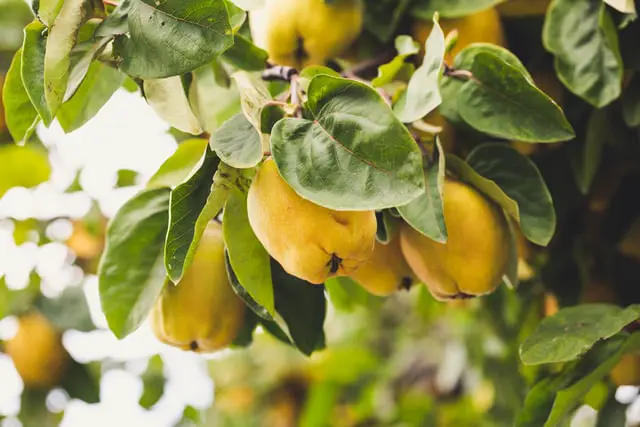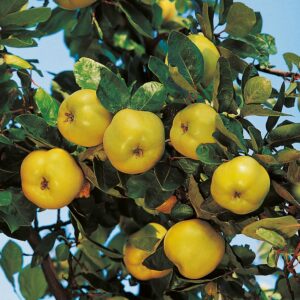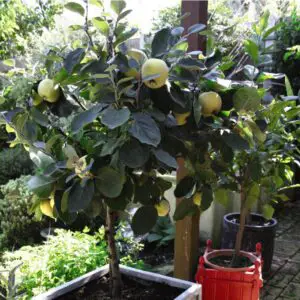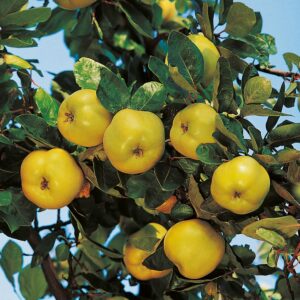Quince trees are easy to care for and not prone to some of the common fruit pests, making them an ideal garden addition. Growing bright yellow pear-shaped fruit, these trees are also very pretty when flowering. Pale pink flowers cover the tree which has a distinctive scent and can be enjoyed from May time. The fruit is ready to harvest around October and will have an aromatic smell and a nice golden colour.

Originating from Iran and Turkestan, quinces often don’t get soft enough to eat here in the UK. In hot sunny climates, they are commonly enjoyed fresh from the tree.
In the UK they are popular in jams, desserts, chutneys, and preserves. The height quince trees will ultimately reach depends on how it’s grown.
You can buy them grafted so they produce dwarf or semi-dwarf plants or a free-standing type that can grow to 5 metres. Fruit will grow on quince trees after two to three years in the right conditions.
Jump To...
How To Grow Quince Trees in the UK
Becoming more popular in gardens, quince trees are a great tree for beginners to grow. They don’t need much care but are extremely ornamental, making them a pleasure to have in the garden.
Our care guide will help you with every stage of the process from when to plant through to pollination facts.
- Quince trees can be planted from March onwards, ideally waiting until the last frost has gone. They flower earlier than other fruit trees so they will do well to avoid possible frost pockets.
- You can buy them as grafted plants or free-standing so it’s really dependent on the space you have available. They need plenty of warm sunshine and do very well against a south-facing wall.
- When the fruit is ripe you will be able to smell its readiness and it will be golden. It won’t necessarily be soft due to the UK climate not being as warm as countries such as Iran where it softens well.
- Pruning quince trees isn’t too taxing and it’s really about removing any weak or diseased branches. You may also need to reduce the number of upwards facing branches so that plenty of light can get through. The lower trunk should be clear of branches.
- Plenty of water during hot spells is vital for the healthy growth of quince trees. Less water is required over winter. In Spring and winter, you can feed your plant with a good-quality fertiliser.
- Soil for quince trees should be nice and moist in the summer but also well-drained so waterlogging isn’t a risk during colder periods.
- Many varieties of quince trees are self-fertile, meaning only one is required to produce fruit.
Growing in Pots
You can also grow quince in a container so if space is an issue you have this very trusty method to fall back on. A patio quince tree can be pot grown and is a beautiful and productive plant to enjoy.
If you have a small garden you can also grow a dwarf quince tree. These compact trees will create fruit in small spaces.
Quince fruit does not often appear in UK shops and even when they do, the price can make your eyes water. Surely another good reason to try your hand at growing your own?
About Quince Trees
Quince is native to Western Asia, Turkey, Georgia, Iran, and Romania – to name just a few.
They like to grow on rocky slopes and woodland areas and can be grown in a range of climates. Medlar trees are often grown on Quince rootstock.
Did You Know?
- The Portuguese name for quince is “marmo” and this is where the word marmalade was derived from.
- There are two shapes of quince fruit – apple and pear and they can vary in size somewhat too.
- One of the best varieties of quince for UK gardens is the Champion Quince.
- Certain religions believe it was quince fruit used by Eve to tempt Adam in the garden of Eden.
Quince FAQ’s
Still got unanswered questions? Fear not, you’ll be clued up on all things quince by the time we’ve finished!
This depends on the one you buy as you can get dwarf varieties and free-standing varieties. They grow modestly, up to around 5 metres at their highest.
If your quince tree is placed in a sunny location and the conditions are good, yours should bear fruit two to three years after planting.
There are plenty of self-fertile varieties of quince trees so just one is needed to produce fruit.
Quince trees are deciduous, losing their leaves in the winter.






why would a Quince tree despite having lots of blossom, drop its fruit?